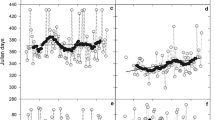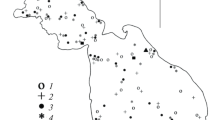Abstract
Strong climate-related secular trends are apparent in a 52-yr long (1947–1998) uninterrupted series of monthly temperature profiles fromLake Zurich, a large, deep (136 m), temperate lake on the Swiss Plateau. Decadal mean water temperatures have undergone a secular increase at all depths, reflecting the high degree of regional warming that occurred in the European Alpine area during the 20th century. From the 1950s to the 1990s, high warming rates (∼ 0.24 K per decade) in the uppermost 20 m of the lake (i.e., the epi/metalimnion) combined with lower warming rates (∼ 0.13 K per decade) below 20 m (i.e., in the hypolimnion), have resulted in a20% increase in thermal stability and a consequent extension of 2–3 weeksin the stratification period. In common with many other parts of the world, 20th-century climate change on the Swiss Plateau has involved a steep secular increase in daily minimum (nighttime) air temperatures, but not in daily maximum (daytime) air temperatures. With respect to both secular change and decadal-scale variability, the temporal structure of the temperature of the surface mixed layer of Lake Zurich faithfully reflects that of the regional daily minimum air temperature, but not that of the daily maximum. The processes responsible for longer-term changes in the temperature structure of the lake therefore act during the night, presumably by suppressing nighttime convective cooling of the surface mixed layer. Application of a one-box heat exchange model suggests that the observed secular changes in thermal structure are due to shifts in the nighttime rate of emission of infrared radiation from the atmosphere and in the nighttime rates of latent and sensible heat exchange at the air-water interface. The increase in hypolimnetic temperatures is mainly a result of the increased prevalence of warm winters in Europe.
Similar content being viewed by others
References
Ambrosetti, W., and Barbanti, L.: 1999, ‘Deep Water Warming in Lakes: An Indicator of Climatic Change’, J. Limnol. 58, 1–9.
Arnell, N., Bates, B., Lang, H., Magnuson, J. J., and Mulholland, P.: 1996, ‘Hydrology and Freshwater Ecology’, in Watson, R. T., Zinyowera, M. C., Moss, R. H., and Dokken, D. J. (eds.), Climate Change 1995 —Impacts, Adaptations and Mitigation of Climate Change: Scientific–Technical Analyses. Contribution of Working Group II to the Second Assessment Report of the Intergovernmental Panel on Climate Change, Cambridge University Press, Cambridge, pp. 325–363.
Beniston, M., Rebetez, M., Giorgi, F., and Marinucci, M. R.: 1994, ‘An Analysis of Regional Climate Change in Switzerland’, Theor. Appl. Climatol. 49, 135–159.
Brock, T. D.: 1981, ‘Calculating Solar Radiation for Ecological Studies’, Ecol. Modelling 14, 1–19.
Chen, C. T. and Millero, F. J.: 1986, ‘Precise Thermodynamic Properties for NaturalWaters Covering Only the Limnological Range’, Limnol. Oceanogr. 31, 657–662.
Cushing, C. E. (ed.): 1997, ‘Freshwater Ecosystems and Climate Change in North America’, Hydrol. Process. Special Issue 11(8), 817–1067.
Denton, G. H. and Karlén, W.: 1973, ‘Holocene Variations — Their Pattern and Possible Cause’, Quatern. Res. 3, 155–205.
Dingman, S. L.: 1972, ‘Equilibrium Temperature of Water Surfaces as Related to Air Temperature and Solar Radiation’, Water Resour. Res. 8, 42–49.
Edinger, J. E., Duttweiler, D. W., and Geyer, J. C.: 1968, ‘The Response of Water Temperatures to Meteorological Conditions’, Water Resour. Res. 4, 1137–1143.
Gammeter, S., Forster, R., and Zimmermann, U.: 1998, ‘Limnologische Untersuchung des Zürichsees 1972–1996’, Gas Wasser Abwasser, 78, 327–336.
Hondzo, M. and Stefan, H. G.: 1991, ‘Three Case Studies of Lake Temperature and Stratification Response to Warmer Climate’, Water Resour. Res. 27, 1837–1846.
Hondzo, M. and Stefan, H. G.: 1993, ‘Regional Water Temperature Characteristics of Lakes Subjected to Climate Change’, Clim. Change 24, 187–211.
Hormes, A., Schlüchter, C., and Stocker, T. F.: 1998, ‘Minimal Extension Phases of Unteraarglacier (Swiss Alps) during the Holocene Based on C–14 Analysis ofWood’, Radiocarbon 40, 809–817.
Hurrell, J. W.: 1995, ‘Decadal Trends in the North Atlantic Oscillation: Regional Temperatures and Precipitation’, Science 269, 676–679.
Hutchinson, G. E.: 1957, A Treatise on Limnology, Vol. 1: Geography, Physics and Chemistry,Wiley, New York, 1015 pp.
Idso, S. B.: 1973, ‘On the Concept of Lake Stability’, Limnol. Oceanogr. 18, 681–683.
Imberger, J.: 1985, ‘The Diurnal Mixed Layer’, Limnol. Oceanogr. 30, 737–770.
Jones, P. D. and Briffa, K. R.: 1992, ‘Global Surface Air Temperature Variations during the Twentieth Century: Part 1, Spatial, Temporal and Seasonal Details’, Holocene 2, 165–179.
Karl, T. R., Kukla, G., Razuvayev, V. N., Changery, M. J., Quayle, R. G., Heim, R. R. Jr., Easterling, D. R., and Fu, C. B.: 1991, ‘Global Warming: Evidence of Asymmetric Diurnal Temperature Change’, Geophys. Res. Lett. 18, 2253–2256.
Kasten, F. and Czeplak, G.: 1980, ‘Solar and Terrestrial Radiation Dependent on the Amount and Type of Cloud’, Solar Energy 24, 177–189.
Kattenberg, A., Giorgi, F., Grassl, H., Meehl, G. A., Mitchell, J. F. B., Stouffer, R. J., Tokioka, T., Weaver, A. J., and Wigley, T. M. L.: 1996, ‘Climate Models — Projections of Future Climate’, in Houghton, J. J., Meiro Filho, L. G., Callender, B. A., Harris, N., Kattenberg, A., and Maskell, K. (eds.), Climate Change 1995 — the Science of Climate Change. Contribution of Working Group I to the Second Assessment Report of the Intergovernmental Panel on Climate Change, Cambridge University Press, Cambridge, pp. 285–357.
Kukla, G. and Karl, T. R.: 1993, ‘NighttimeWarming and the Greenhouse Effect’, Environ. Sci. Tech. 27, 1468–1474.
Kutschke, I.: 1966, ‘Die thermischen Verhältnisse im Zürichsee zwischen 1937 und 1963 und ihre Beeinflussung durch meteorologische Faktoren’, Vierteljahrsschr. Naturf. Ges. Zürich 111, 47–124.
Lister, G. S., Livingstone, D. M., Ammann, B., Ariztegui, D., Haeberli, W., Lotter, A. F., Ohlendorf, C., Pfister, C., Schwander, J., Schweingruber, F., Stauffer, B., and Sturm, M.: 1998, ‘Alpine Paleoclimatology’, in Cebon, P., Dahinden, U., Davies, H. C., Imboden, D. M., and Jaeger, C. C. (eds.), Views from the Alps: Regional Perspectives on Climate Change, MIT Press, pp. 73–169.
Livingstone, D. M.: 1993, ‘Temporal Structure in the Deep–Water Temperature of Four Swiss Lakes: A Short–Term Climatic Change Indicator?’, Verh. Internat. Verein. Limnol. 25, 75–81.
Livingstone, D. M.: 1997a, ‘Break–Up Dates of Alpine Lakes as Proxy Data for Local and Regional Mean Surface Air Temperatures’, Clim. Change 376, 407–439.
Livingstone, D. M.: 1997b, ‘An Example of the Simultaneous Occurrence of Climate–Driven “Sawtooth” Deep–Water Warming/Cooling Episodes in Several Swiss Lakes’, Verh. Internat. Verein. Limnol. 26, 822–826.
Livingstone, D.M.: 2000, ‘Large–Scale Climatic Forcing Detected in Historical Observations of Lake Ice Break–Up’, Verh. Internat. Verein. Limnol. 27, 2775–2783.
Livingstone, D. M. and Dokulil, M. T.: 2001, ‘Eighty Years of Spatially Coherent Austrian Lake Surface Temperatures and their Relationship to Regional Air Temperature and the North Atlantic Oscillation’, Limnol. Oceanogr. 46, 1220–1227.
Livingstone, D. M. and Imboden, D. M.: 1989, ‘Annual Heat Balance and Equilibrium Temperature of Lake Aegeri, Switzerland’, Aquat. Sci. 51, 351–369.
Livingstone, D. M. and Imboden, D. M.: 1996, ‘The Prediction of Hypolimnetic Oxygen Profiles: A Plea for a Deductive Approach’, Can. J. Aquat. Sci. 53, 924–932.
Livingstone, D. M. and Lotter, A. F.: 1998, ‘The Relationship between Air and Water Temperatures in Lakes of the Swiss Plateau: A Case Study with Palæolimnological Implications’, J. Paleolim. 19, 181–198.
Livingstone, D. M., Lotter, A. F, and Walker, I. R.: 1999, ‘The Decrease in Summer Surface Water Temperature with Altitude in Swiss Alpine Lakes: A Comparison with Air Temperature Lapse Rates’, Arctic Antarctic Alpine Res. 31, 341–352.
Magnuson, J. J., Robertson, D. M., Benson, B. J., Wynne, R. H., Livingstone, D. M., Arai, T., Assel, R. A., Barry, R. G., Card, V., Kuusisto, E., Granin, N. G., Prowse, T. D., Stewart, K. M., and Vuglinski, V. S.: 2000, ‘Historical Trends in Lake and River Ice Cover in the Northern Hemisphere’, Science 289, 1743–1746.
McKnight, D., Brakke, D. F., and Mulholland, P. J. (eds.): 1996, ‘Freshwater Ecosystems and Climate Change in North America’, Limnol. Oceanogr. Special Issue 41(5): 815–1149.
Omlin, M., Reichert, P., and Forster, R.: 2001, ‘Biochemical Model of Lake Zurich: Model Equations and Results’, Ecol. Modelling 144, 77–103.
Örn, C. G.: 1980, ‘Die Sauerstoffverhältnisse im Zürichsee (Untersee) von 1937 bis 1975 und ihre Beeinflussung durch meteorologische Faktoren’, Vierteljahrsschr. Naturf. Ges. Zürich 125, 259–364.
Paeth, H., Hense, A., Glowienk–Hense, R., Voss R., and Cubasch, U.: 1999, ‘The North Atlantic Oscillation as an Indicator for Greenhouse–Gas Induced Regional Climate Change’, Clim. Dyn. 15, 953–960.
Peeters, F., Livingstone, D. M., Goudsmit, G.–H., Kipfer, R., and Forster, R.: 2002, ‘Modeling 50 yr of Historical Temperature Profiles in a Large Central European Lake’, Limnol. Oceanogr. 47, 186–197.
Plantico, M. S., Karl, T. R., Kukla, G., and Gavin, J.: 1990, ‘Is Recent Climate Change across the United States Related to Rising Levels of Anthropogenic Greenhouse Gases?’, J. Geophys. Res. 95, 16 617–16 637.
Rebetez, M. and Beniston, M.: 1998, ‘Changes in Sunshine Duration are Correlated with Changes in Daily Temperature Range this Century: An Analysis of Swiss Climatological Data’, Geophys. Res. Lett. 25, 3611–3613.
Regier, H. A., Holmes, J. A., and Panly, D.: 1990, ‘Influence of Temperature Changes on Aquatic Ecosystems: An Interpretation of Empirical Data’, Trans. Am. Fish. Soc. 119, 374–389.
Robertson, D. M. and Ragotzkie, R. A.: 1990, ‘Changes in the Thermal Structure of Moderate to Large Sized Lakes in Response to Changes in Air Temperature’, Aquatic Sci. 52, 360–380.
Röthlisberger, F., Haas, P., Holzhauser, H., Keller, W., Bircher, W. and Renner, F.: 1980, ‘Holocene Climatic Fluctuations — Radiocarbon Dating of Fossil Soils and Woods from Moraines and Glaciers in the Alps’, Geogr. Helv. 35, 21–52.
Schindler, D. W., Bayley, S. E., Parker, B. R., Beaty, K. G., Cruikshank, D. R., Fee, E. J., Schindler, E. U., and Stainton, M. P.: 1996, ‘The Effects of Climatic Warming on the Properties of Boreal Lakes and Streams at the Experimental Lakes Area, Northwestern Ontario’, Limnol. Oceanogr. 41, 1004–1017.
Schindler, D.W., Beaty, K. G., Fee, E. J., Cruikshank, D. R., DeBruyn, E. R., Findlay, D. L., Linsey, G. A., Shearer, J. A., Stainton, M. P, and Turner, M. A.: 1990, ‘Effects of Climatic Warming on Lakes of the Central Boreal Forest’, Science 250, 967–970.
Schmidt, W.: 1928, ‘Über Temperatur–und Stabilitätsverhältnisse von Seen’, Geogr. Ann. 10, 145–177.
Schüepp, M.: 1968, ‘Klimatologie der Schweiz, C: Lufttemperatur, 5. bis 8. Teil’, Beih. Annal. Schweiz. Meteorol. Zentralanstalt (Jahrgang 1967), C107–C153.
Stefan, H. G., Fang, X., and Hondzo, M.: 1998, ‘Simulated Climate Change Effects on Year–Round Water Temperatures in Temperate Zone Lakes’, Clim. Change 40, 547–576.
Stefan, H. G. and Sinokrot, B. A.: 1993, ‘Projected Global Climate Change Impact on Water Temperatures in Five North Central U.S. Streams’, Clim. Change 24, 353–381.
Sweers, H. H.: 1976, ‘A Nomogram to Estimate the Heat–Exchange Coefficient at the Air–Water Interface as a Function of Wind Speed and Temperature; A Critical Survey of some Literature’, J. Hydrol. 30, 375–401.
Weber, R. O., Talkner, P., and Stefanicki, G.: 1994, ‘Asymmetric Diurnal Temperature Change in the Alpine Region’, Geophys. Res. Lett. 21, 673–676.
Weber, R. O., Talkner, P., Auer, I., Böhm, R., Gajic–Capka, M., Zaninovic, K., Brázdil, R., and Fasko, P.: 1997, ‘20th–Century Changes of Temperature in the Mountain Regions of Central Europe’, Clim. Change 36, 327–344.
Author information
Authors and Affiliations
Rights and permissions
About this article
Cite this article
Livingstone, D.M. Impact of Secular Climate Change on the Thermal Structure of a Large Temperate Central European Lake. Climatic Change 57, 205–225 (2003). https://doi.org/10.1023/A:1022119503144
Issue Date:
DOI: https://doi.org/10.1023/A:1022119503144




